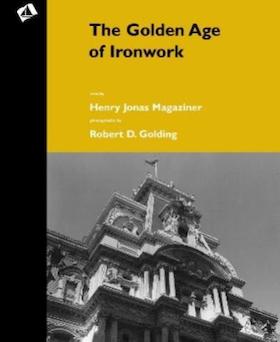
Home of the world famous 'finishing.com HOTLINE' since 1989
-----
Finishing of Kenrick 19th Century Cast Iron
Q. I have a question regarding the finishing of 19th century cast iron. I have numerous items of Kenrick cast iron door furniture (knobs and knockers, etc.) manufactured between 1860 and 1895 in West Bromwich. They are of variable condition and if possible I would like to restore their original finish. I know that "bronzing" (if someone could define this in relation to cast iron I would appreciate it) was sometimes used as a finish in the late 1800's but I guess this was not the manufacturer's original protective finish. Some of my items have a brown coating (not rust) over the cast iron that appears to be a finish that may have discolored.
Any information would be greatly appreciated.
1996
A. In looking at The Chemical Formulary", Volume 5, Chemical Publishing Co., Inc, 1941, Brooklyn, New York [on eBay , Amazon, AbeBooks affil links] it seemed to me that the original brown finish could be:
- antiqued bronze plating ( electrolytically plate a clean iron surface with a copper-tin alloy, and dip in something which forms a brown surface (perhaps a sulfur compound) or they could have been bright bronze which weathered to the brown finish.
- an organic coating. The one I would have you try first is British Patent # 494,963:
Heat tung oil ⇦ on eBay or Amazon [affil link] 200 gals. for 15-20 min. at 340 °C. until it approaches gelatinous stage and then add sardine oil 20 gal. cool and then add whale oil 60 gal., sardine oil 200 gal. and 1/2 percent by volume of manganese cobalt drier. (If you get this on your clothes, don't bother going home) - Maybe a cadmium coating with some kind of post treatment, but you don't want to use this one, even if it is original. Cadmium is too poisonous, as it turns out.
So I think an antique bronze or bright bronze from a modern electroplating bath may be the best bet, depending upon how valuable these items are. I bet it would cost you US $20 or $30 a piece to deoxidize, strip, buff, plate, and antique these things to a nice finish.
Being into documentation, I would recommend that you describe the proper treatment for restoring the pieces, to try to avoid someone dissolving them away in the first pickle bath in which they are immersed. I'm not saying platers are stupid, but this kind of thing has happened before. Besides, do a good story on this, and we will publish your article on these pages. A scientific study of restorations makes for the most interesting reading. You know; before and after pictures, a photo op for some laboratory in a big corporation, charts and tables, a picture of you in some old library, blowing the dust off of some tome, it breaks up the dull day.
I would try to find some interested metallurgist in a materials lab who might do an Auger analysis, or somehow find out the composition of the coating and base metal. Armed with an analysis, you might get some
plating consultant to write up the procedure to replate them.

Tom Pullizzi
Falls Township, Pennsylvania
A. Hi J.
Please test it with a magnet because my first guess would have been that it might be cast brass or bronze rather than cast iron, which would make the brown color less unusual.
Luck & Regards,

Ted Mooney, P.E. RET
Striving to live Aloha
finishing.com - Pine Beach, New Jersey
Ted is available for instant help
or longer-term assistance.
Q. I live in an old stone terrace house with old cast Iron bath in very small bathroom, the tub is 2 inches shorter than normal bath so replacing is not an option; it has been re-Enameled before but is now badly stained and turning brown but in good condition, but I am having trouble locating somewhere to purchase Enamel from, Can you help me? Any info would be appreciated.
Mr Neil Waters- Wales, U.K.
2002
A. The thing is, Neil, that the original enamel was probably porcelain enamel, applied something like how glass is made--with a ceramic frit that is melted and fused at extremely high temperature (thousands of degrees) onto the cast iron. You can't do that, sorry, so you're restricted to paint (which just isn't as good); but you could look up "baththub refitters" for forms that do such painting. If you want to do it yourself, thread 22525, "Bathtub repainting/refinishing" is about successes and failures at this enterprise.

Ted Mooney, P.E.
Striving to live Aloha
finishing.com - Pine Beach, New Jersey
Ted is available for instant help
or longer-term assistance.
Q. Hi,
could anyone help me in my quest to find information on a 19th century cast iron horse head / horseshoe door knocker which has the following wording on the back- REGD NOVR.1884 CARTER FOUNDRY No 484. Not having much success in my research at all so any help at all would be great.

Many thanks
Gordon
- Scotland
March 21, 2013
A. To my knowledge the finish on the "standard" Kenrick door knocker is not documented but porcelain enamel fills the bill, both from my observations of well preserved knockers and because its "hardness" is a real advantage. Whatever the finish used it was essential to prevent "rusting" in the English climate. I don't believe it was a "clear" lacquer or even a "coloured" lacquer [gold, bronze, etc.], which while the latter was used for brass microscopes, magic lantern lenses, etc., it would not able to survive the travails of the weather facing the outdoor knocker. With regard to Kenrick door knockers 2 additional finishes were offered in some cases, namely Berlin Black and French Bronze, at six pence extra [nearly an 30% more than the "base" price for the knocker]. This latter French Bronze finish is not uncommonly seen on late 19th century knockers causing vendors to refer to them as "brass". Incidentally, a local company [?], Porter's Original Paints, now supply a similar product called Liquid Bronze, which can be buffed to a similar finish. On some knockers a true brass component could be ordered -- e.g., the door plate mount --- but given the different moulding/casting procedures required for the separate pieces in cast iron and bronze [different chillers for example], the added expense was substantial. For example Kenrick No. 365 had a base price of 1 shilling and three pence but this became 5 shillings and six pence if supplied with just a brass centre rather than the cheaper cast iron.
Finally, sorry to be so boring, but not all cast iron is the same formulation with a higher carbon content [and hence more malleability for superb casting] was used on door knockers [given their "first impression" status] compared with cast iron boot scrapers. But I could be wrong. It would be important knowledge to have as wherever possible the original finish should be preserved.
But for heavily rusted items or those with multiple coats of paint I use a caustic paint-stripper to remove most paint [not always effective, but I haven't used a heat gun ⇦ on eBay or Amazon [affil link] , yet] then any paint remaining using a brass wire brush ⇦ on eBay or Amazon [affil link] . The final finishing I do with a 3000 Dremel ⇦ on eBay or Amazon [affil link] and a Dremel 428 steel wire brush, and a final buff with a cotton Dremel brush. I like to feel that this is how the knocker looked coming out of the mould, so I do nothing more, just keep them free of moisture [hygroscopic crystals] in a display cabinet. Who says collectors are obsessive?
Garry Scroop- Adelaide, South Australia
July 2, 2015
Ed. note: Garry is the author of "The Art of the Door Knocker"
![]() Hi again. Just an update on my previous answer. I supported Ted Mooney's comment about porcelain enameling as a likely finish on cast iron products of the 19th century. I now have some harder evidence to support him. In 1846 Timothy Kenrick of Kenrick and Sons at the West Bromwich Foundry was granted a patent for "the glazing and enameling of cast iron which led to investment and the growth of home and overseas sales"
Hi again. Just an update on my previous answer. I supported Ted Mooney's comment about porcelain enameling as a likely finish on cast iron products of the 19th century. I now have some harder evidence to support him. In 1846 Timothy Kenrick of Kenrick and Sons at the West Bromwich Foundry was granted a patent for "the glazing and enameling of cast iron which led to investment and the growth of home and overseas sales"
I think all in all dear friends, that's a QED.
- Adelaide, South Australia
Ed. note: Garry is the author of "The Art of the Door Knocker"
Q. Hello, I am not at all knowledgeable about this topic and would appreciate any input.
Recently purchased a door knocker from eBay that says Kenrick and No 313 on the back. It appears brass colored with dirt and other dark discolorations . Did Kenrick make brass colored knockers? From reading this thread seems like they made wrought iron. Is this correct? If so does anyone know if this can be a genuine Kenrick or a knockoff?
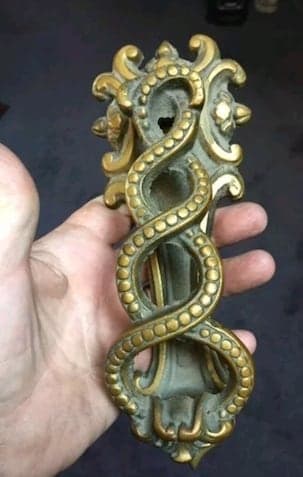
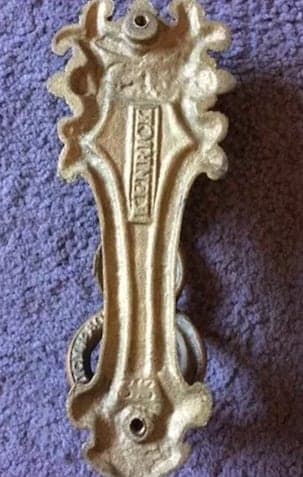
If anyone could tell me what best to use to restore it, would be very thankful.
Ross Mathew- Stamford, Connecticut, USA
April 16, 2019
A. Hi Ross. It doesn't look to me like it needs any restoration; I think the recessed areas are supposed to be blackish. A magnet will quickly tell you whether it's cast iron or cast brass.
On the one hand, 'knockoff' can mean a recently made item built by a reputable outfit but in the general style of older traditional items; and on the other hand it can mean "counterfeit". Reputable outfits certainly would not cast the word "Kenrick" into their items; and, although your item is very beautiful and you should enjoy it, I doubt that it is so valuable as to inspire counterfeiting ... so I'd say it's almost surely real.
Regards,

Ted Mooney, P.E. RET
Striving to live Aloha
finishing.com - Pine Beach, New Jersey
Ted is available for instant help
or longer-term assistance.
![]() Thank You Ted Mooney! Saw a 350$ diff. in price between mine and others online in 1st dibs, etc., hence the concern. Either way, like you said, will certainly enjoy.
Thank You Ted Mooney! Saw a 350$ diff. in price between mine and others online in 1st dibs, etc., hence the concern. Either way, like you said, will certainly enjoy.
- Stamford, Connecticut, USA
A. If you want all the answers on EVERYTHING about Kenrick door knockers and more, buy or read my 2019 book of 315 pages titled "The Art of the Door Knocker".
Garry Scroop [returning]- ADELAIDE, south australia
May 26, 2021
Ed. note: Garry is the author of "The Art of the Door Knocker"
? Hi. That's great Garry, but how does one do that? I'm not seeing your book available for sale anywhere, and WorldCat shows it available only in four libraries in Australia.
Luck & Regards,

Ted Mooney, P.E. RET
Striving to live Aloha
finishing.com - Pine Beach, New Jersey
Ted is available for instant help
or longer-term assistance.
A. My fault Ted
The book has door knockers and full catalogues of Kenrick and others plus lots more but focuses on Kenrick. It cost me $40 just to print locally and postage to UK costs 50 GBP and that's the problem. I am a true scientist so the book is right up to the mark. Go to Garry Scroop on the internet to find my sorry sad tale.
Garry
Retired - ADELAIDE, South Australia
Ed.update: Gary Scroop's "Art of the Door Knocker" is available from:
• OpenBook at www.openbookhowden.com.au/product/the-art-of-the-doorknocker/ or can be borrowed from
• National Library of Australia at catalogue.nla.gov.au/catalog/10021164
A. Hi Ross
I have 2 examples of the cast iron versions of AKS door knocker No. 313. Both are 22.5 cm or 8-3/4 inches long and 9 cm or 3-1/2 inches at the widest part. The first example I have is what I presume to be an earlier casting, where the only foundry mark is the number '313' which is 'engraved' vertically on the reverse of the door plate at the top end towards the right edge, but nothing else.
The second example I have has 2 foundry marks. Firstly, on the reverse of the door plate are the same markings as on your brass version, namely KENRICK 'embossed' vertically at the top and 313 'engraved' horizontally at the bottom of the door plate. Secondly, on the knocker arm, on the left side of the bottom 'loop', viewed from the back, again 'embossed' is KENRICK & SON(S). I have seen your brass version and there is good evidence that a few of the longer lasting AKS patterns were offered in brass after 1900, and yours is almost certainly original. A brass polish with a tooth brush and then buffed is perfectly acceptable, but to me they never appear as 'sharp' as the cast iron versions. Where I have used the terms 'engraved' and 'embossed'. I am of course referring to how the original casting appears to the modern viewer at this stage. The cast iron version of AKS door knocker 313 weighed 844 gm and cost 1/2d in 1899. All in my book.
Garry ScroopRetired collector - ADELAIDE, South Australia
January 30, 2022
Ed. note: Garry is the author of "The Art of the Door Knocker"
Q. Hi Garry,
I see you're Australian, as am I, based in Brisbane. I'm currently trying to restore our front door pull and it appears to be a Kenrick and Sons cast Iron.
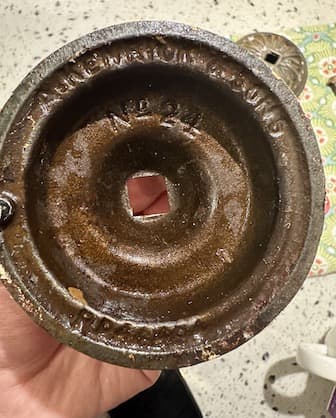
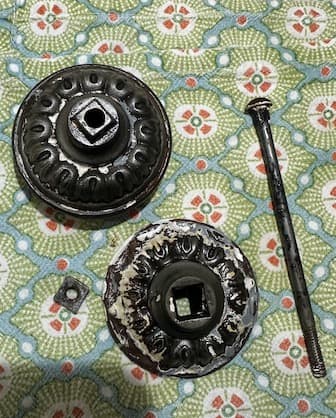
I am wondering if you would have any thoughts about its vintage? I'm in the process of removing layers of the old paint. The inside of the back plate which hasn't been painted appears to be a brownish enamel. Once I've removed all the paint and the rust would you have any suggestions on the best product to use to protect the cast iron? Paint? Epoxy enamel? Oil? I don't really know what I'm doing but love restoring old things! Thank you
Amy Leigh- QLD, Australia
January 14, 2025
A. Try tannic acid treatment (you can use tannin rich leaves of some aussie plants like eucalyptus or accacia too )as first step and then baked shellac (30 minute at 120 °C) or nitrocellulose lacquer (baked too). There are special hardware clearcoats too (most of them epoxy based). Hope it helps and good luck!
Goran Budija- Cerovski vrh Croatia
January 23, 2025
Q. I'm in Australia and have owned an antique gothic Victorian goat iron cast Kenrick door knocker for the last 30 years, I'm 99% sure it's authentic but haven't had it appraised before. I haven't seen many online or original ones, I would appreciate your help on its authenticity. Thank you.
Emelia Best- Melbourne Australia
July 1, 2022
A. Hi Emelia. This isn't an appraisal or authentication service, but readers will need at least a photo before they can help. E-mail it to [email protected]. Thanks!
Kenrick door knockers are nice, but I doubt that they are so valuable that forgeries, complete with the Kenrick name embossed in the molds, would make economic sense for a counterfeiter.
Kenrick Door Knockers
on eBay
(affil link)
Luck & Regards,

Ted Mooney, P.E. RET
Striving to live Aloha
finishing.com - Pine Beach, New Jersey
Ted is available for instant help
or longer-term assistance.
No dead threads!
Your Q, A, or Comment puts this thread on The Finishing.com HOTLINE.
